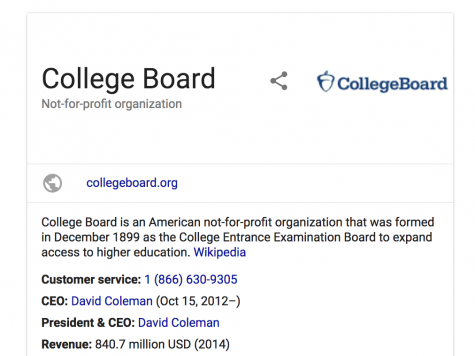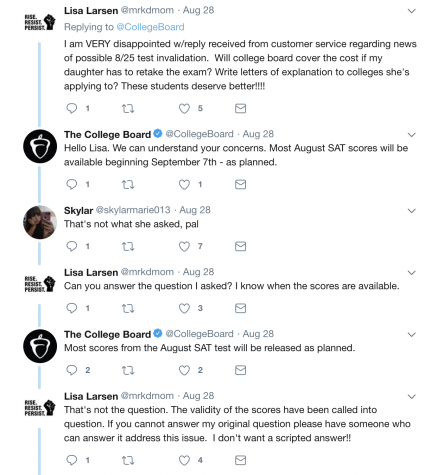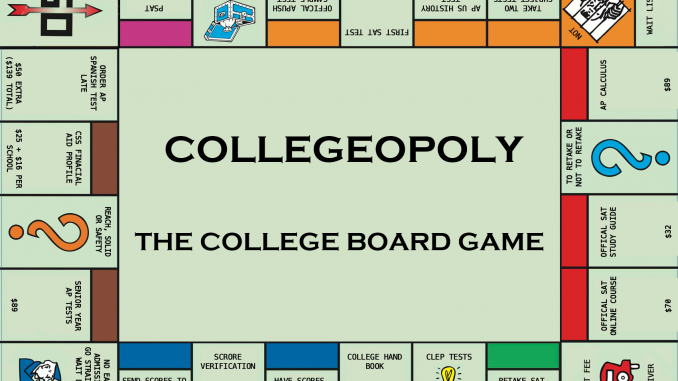Why Everyone Hates the College Board
The lowdown on an extremely profitable “nonprofit”
September 5, 2018
If you’re a high school student, no matter who you are – an athlete, a performer, an artist, an academic, all of the above, or none of the above – you undoubtedly share one quality with over one million American teenagers: you hate (abhor, detest, loathe–gotta get that SAT vocabulary in) the College Board.
For those unfamiliar with the College Board, it is a “not-for-profit organization” that administers the SAT, AP, and other horrible acronyms that plague a high schooler’s life. College Board tests are vital to a college application. Thus, students who apply to college have no way to avoid the College Board, since they run a monopoly over education and the college admissions system.
Like most monopolies, the College Board doesn’t use its ubiquitous power for the good of the people. Instead, it appears to be focused on one ironic thing: revenues.
Problem #1: The College Board is classified as a not-for-profit organization under the national tax code.
The organization promotes this label, while exploiting high schoolers’ anxiety about college admissions. It makes $840 million per year.

Google strategically places the College Board’s $841 million revenue under their “not-for-profit” status.
Problem #2: The College Board costs your parents a lot of money.
1.7 million high school students took the SAT in 2017. The cost of the test is about $48, and about $65 if you choose to write the essay. One in four students who took the test used a fee waiver. This 25% only makes up the population that legally cannot afford to pay for the test. What about the kids whose parents make just enough to brush past the fee waiver qualifications but not enough to spare a few hundred on standardized tests, considering that most students take the SAT more than once?
Then there are AP tests. If you want to show colleges that you’re capable of higher-level academics, you’ll probably take multiple AP tests for “college credit.” The problem here? The cost of a single AP test was ninety-four dollars last year, with an expected price increase of a dollar this year.
As if AP tests and the SAT aren’t enough, the College Board also administers SAT Subject Tests to further prove to colleges that you’re competent in certain subjects–something that can already be proved by just a quick glance over our transcripts. Or a stellar AP Exam score. Each test is $22-26, along with a “registration fee” of $26, because the College Board wouldn’t be itself without milking a few extra dollars out of the families of high school students.
When the dreaded college application season rolls around, you’ll finally get to send colleges your AP and SAT scores. You’ll think to yourself, “the hard part is done. All that’s left is a simple click of a button.”
However, there’s a catch: you still have to pay to send out your scores. Every score report costs $11.25. If you’re applying to four schools, you have to pay another $45 to actually send out your scores.
Essentially, we pay hundreds of dollars to take tests we’re essentially forced to take. Then, we pay hundreds of dollars to send out scores we’re required to send out.
Problem #3: Every time you think they’ll help you, they con you again.
You look at your SAT results, and maybe you didn’t do as well as you would’ve liked to. Suddenly, “SAS” luminesces from your screen as if it were divine intervention. You are feeling hopeless about your score, and the Student Answer Service seems like a lifeline to save you.
Don’t click.
The SAS is yet another College Board scam to con you out of your money. This $13.50 service tells you whether you got a question correct or incorrect and gives you a vague description of what type of question you missed. In other words, the SAS tells you what the SAT report details already tell you.
Problem #4: The SAT is not standardized.
There are some instances where the test seems reasonable, but then you get your scores back and you want to cry and rip your hair out because your score is unreasonably low. The tests are never the same level of difficulty, and thus, scores across different test dates are all over the place. This is a major problem.
Take the June 2018 SAT, for example. The test was less challenging than those from other months; however, because it was considered an easier test, the curve was brutal. One missed question in the math section brought you down to a 770. Across other tests, you could miss 1 or 2 questions and get a perfect 800.
Here’s the thing: the curves are not based on how well students do. In other words, if everyone does poorly, the College Board does not provide a bigger curve. This is based off of a process called equating. As mentioned earlier, the tests all vary in difficulty. The College Board takes this into account. You are first given a raw score, directly correlated to how many questions you miss. The raw score is converted into a scaled score, adjusted for difficulty. So, the College Board “curves” your test depending on how difficult they believe it is.
Problem #5: The integrity of the SAT is compromised.
The College Board mishandled the June SAT scores. You’d think that it would have learned from its mistakes. But how did the organization compensate for that ridiculously unfair curve? It created a test that used questions from a previous test.
The 2018 August SAT, which may be the biggest scandal yet, was a recycled version of an international SAT test. Since most test answers are leaked online, people who did SAT prep beforehand were at an obvious advantage. You know, because they saw the test answers.
Here’s the better part: The College Board is not cancelling any of the scores.
Problem #6: The College Board fails to address pressing issues.
We all make mistakes, but they can be forgiven. However, the College Board refuses to even acknowledge their mistakes.
No refunds were given for the June SAT, despite it being one of the most unfair curves in the history of the SAT. There is currently no investigation into the August SAT, and the scores are not going to be cancelled – even though they should be invalid.
The College Board does not even take time to thoroughly answer individual concerns.

The College Board Twitter account provided the same vague, insufficient answer to every question Lisa posed.
Problem #7: The College Board states that it doesn’t sell students’ information.
This is completely false. Every test provided by the College Board has an option to check yes for a “Student Search Service,” which they claim “connects students to educational and scholarship opportunities.”
Checking the box to participate not only floods your inbox with daily emails from colleges you probably don’t want to go to, but it also earns the College Board even more money. The organization’s website includes a pricing table showing the rates colleges can pay to obtain students’ information from the College Board.
The bottom line? We all hate the College Board, and infuriatingly enough, there’s nothing we can do about it.
The College Board recognizes its dominance and uses it to exploit vulnerable and utterly powerless high school students. That’s why we sit there with our arms crossed when we get a lower SAT score than the last time, even though we objectively did worse on the last test — yet we continue to begrudgingly pay $50 to register for the next month.
That’s why we don’t expect answers even though we demand them. That’s why we continue to shell out hundreds, maybe thousands of dollars, even though we know it’s unjust.















Livid Mom • Feb 17, 2023 at 3:37 pm
Fantastic article, although it doesn’t mention that College Board is also responsible for collecting a vast amount of personal financial information as part of the CSS form that more is required by more than 250 schools. I was livid when I clicked the CSS link and it took me to The College Board website.
Frustrated Student • Aug 21, 2021 at 12:55 pm
And another reason why they are trash is that they always tend to take time to respond to a customer and answer questions by saying they will get back to us in five to ten business days. That is like saying you will take a whole day to answer two plus two!! Also, may I remind you all that this year other kids have their scores out but no matter how many times I would call or how many times they assure they are working on sending my score I STILL CANNOT SEE MY AP EXAM SCORE??
Frustrated Dad • Aug 24, 2020 at 10:57 am
CB needs to get their act together…requiring students to take the same exam a third time due to their “technical malfunctions”. Really? Recess is over folks. Time to work out your elementary-level technical problems. Walk the walk.
Aileen Cossu • Mar 27, 2020 at 3:25 pm
All of you smart students should get together and come up with a REAL tool that would put college board out of business. It’s a total scam and does not produce a lick of relevance by having students spend 4 hours on a Saturday morning after an entire week of ap and honors classes, tests and homework and then spend your Saturday morning trying to do well on a test that bares absolutely no reflection on your caliber and competence as qualified students. IT’s tragic that colleges and universities dont invest in their own tool to fix this farse instead of taking the easy way out and just going with it because its there.
Margaret • Feb 28, 2020 at 1:08 pm
don’t forget that they make you pay to apply for financial aid! if you have to fill out the CSS profile, (which many schools make you do), you have to pay like $10 PER SCHOOL! and they don’t tell you beforehand. so yeah, I hate the college board.
Raj Krish • Dec 1, 2019 at 5:18 pm
More about College Board scam
The Wallstreet Journal
For Sale: SAT-Takers’ Names. Colleges Buy Student Data and Boost Exclusivity
For 47 cents, the College Board will sell an individual’s information, feeding admissions frenzy
https://www.wsj.com/articles/for-sale-sat-takers-names-colleges-buy-student-data-and-boost-exclusivity-11572976621
By Douglas Belkin
@DOUGBELKIN
[email protected]
Nov. 5, 2019
https://www.mic.com/p/college-board-sells-student-data-to-schools-that-use-it-to-boost-exclusivity-new-report-19302423
April • Nov 26, 2019 at 1:19 pm
Not to mention it’s the jenkiest site ever. Tons of broken links, poorly organized, the phone calls constantly drop, and they outsource customer service to India. The woman had to put me on hold and “check her resources” of every little question. With all that money you think they’d have the decency to cover the basics.
Renato Cabagna • Oct 30, 2019 at 10:26 pm
We must refuse to take these tests, no matter how hard it might seem to let go of that stanford or harvard application. It’s the only way to save all the Lisa’s out there!!!
anna buice • May 14, 2019 at 7:27 pm
I dont understand why people don’t care about this.
fat guy • Apr 1, 2019 at 3:22 pm
there has to be something we can do about it
Prefer to be Anonymous • Apr 1, 2019 at 3:20 pm
Why do evil people like the college board always win??? Ugh its’s so frustrating
TheCreature • Sep 13, 2018 at 5:06 pm
Great to see my favorite staff writer (besides Roman Hladio, of course) is diving into the big issues! Down with the College Board!! Keep it up, Amanda! I’m expecting some hard-hitting pieces from you!